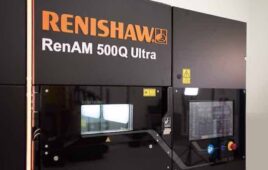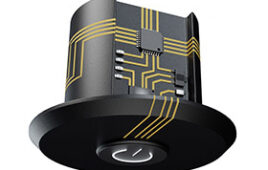Nanofabrica’s additive manufacturing (AM) platform may be the first micron-level resolution AM technology that operates cost-effectively and repeatably, making it an industrial production alternative to traditional manufacturing processes such as micro moulding. Micron resolution can be achieved on centimetre-sized parts, and thousands of parts and components can be made in a single build, making the technology appropriate for mass manufacture.
One area where the technology has found a perfect fit is in the manufacture of various micro optical parts and components. The ability to produce complex, extremely flat, extremely small, and extremely lightweight optics opens up a potential for product innovation in many industrial sectors. In addition, for a variety of reasons including green manufacturing considerations and the design freedom that working in plastic allows, plastic has become an increasingly popular material for micro optic applications.

Cylindrical micro lens, 20 micron high 100 micron wide. Surface roughness in the order of 1 micron, material with 80% transparency for visible light.
Because of this, micro-injection molding has become a popular technology for micro optics manufacturing, and until the launch of Nanofabrica’s AM technology was the really the only viable technology for low cost, high volume production runs.
Use of injection molding for micro-optic manufacture requires the optimization of design, tooling, and production steps, meaning a close interaction between supplier and product developer is vital. The ability for Nanofabrica’s technology to overcome complexity issues and to eliminate the need for tooling is key, and the technology is therefore used for an array of applications such as the manufacture of jigs and fixtures for optical alignment, optical connectors for optical fibers, fiber optic ferrules and other small related elements, and optical elements such as lenses and prisms.

A jig for alignment and coupling of optical fibres (3 mm x 3 mm x 6 mm) printed in ABS. The part has 100 micron holes where optical fibres are placed.
Jon Donner, CEO of Nanofabrica (with a PhD in optics and nano-optics) says, “Currently, most precision optical assemblies are undertaken using precision robotics. With Nanofabrica’s micro AM technology, which is characterized by micron resolution printing capabilities, customers can additively manufacture a jig that allows for precise positioning of optical parts. Currently we have customers using our micro AM platform to make optical connectors and fibers, lenses and prisms, and illumination optics. With continual development of surface finish, we expect to be able to print imaging optics in the very near future.”
Now, manufacturers from across industries that require micron and sub-micron level accuracy and resolution have an AM platform available, and so now these manufacturers have the ability to benefit from the advantages of AM, such as the fact that AM is agnostic to part complexity, and it is possible using AM to design and manufacture unique geometries.
Today, innovation in medical applications is largely driving the micro-optic sector, and is constantly increasing the demand for smaller, higher quality, and more versatile micro-optics. In the medical device sector, micro-optic development is working hand in hand with developments in compact sensors and illumination methods to further refine devices such as endoscopes and various invasive camera applications. It is here that Nanofabrica’s technology is pushing the boundaries, opening up the manufacture of parts and components previously seen as impossible using traditional manufacturing processes.
Donner continues, “Additive manufacturing has many innate advantages as a production tool, among which are the fact that it allows designers to think out of the box when it comes to apparent design restrictions, and of course multiple design iterations can be made speedily to stimulate the creation of innovative end products. But until the launch of Nanofabrica’s micro AM production technology, the requirements from the micro optics sector in terms of ultra-precision and repeatable resolution and surface finish were impossible to achieve through the use of 3D printing. Using a micro AM platform, OEMs can now in a single process create micro-optical polymer-based products with complexity and features such as freeform surfaces that would either be impossible using conventional manufacturing technologies, or be prohibitive in terms of time and cost.”
Nanofabrica
www.nano-fabrica.com
Filed Under: 3D printing • additive • stereolithography






Tell Us What You Think!